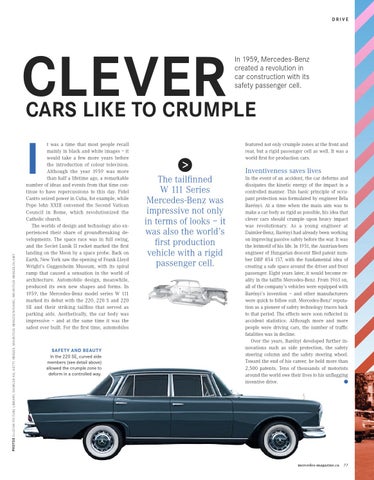DRIVE
CLEVER
In 1959, Mercedes-Benz created a revolution in car construction with its safety passenger cell.
CARS LIKE TO CRUMPLE
PHOTOS ALLSTAR PICTURE LIBR ARY; DAIMLER AG; GET T Y IMAGES; MAURITIUS IMAGES/NOVARC; MAURITIUS IMAGES/AL AMY
I
t was a time that most people recall mainly in black and white images – it would take a few more years before the introduction of colour television. Although the year 1959 was more than half a lifetime ago, a remarkable number of ideas and events from that time continue to have repercussions to this day. Fidel Castro seized power in Cuba, for example, while Pope John XXIII convened the Second Vatican Council in Rome, which revolutionized the Catholic church. The worlds of design and technology also experienced their share of groundbreaking developments. The space race was in full swing, and the Soviet Lunik II rocket marked the first landing on the Moon by a space probe. Back on Earth, New York saw the opening of Frank Lloyd Wright’s Guggenheim Museum, with its spiral ramp that caused a sensation in the world of architecture. Automobile design, meanwhile, produced its own new shapes and forms. In 1959, the Mercedes-Benz model series W 111 marked its debut with the 220, 220 S and 220 SE and their striking tailfins that served as parking aids. Aesthetically, the car body was impressive – and at the same time it was the safest ever built. For the first time, automobiles
SAFETY AND BEAUTY In the 220 SE, curved side members (see detail above) allowed the crumple zone to deform in a controlled way.
featured not only crumple zones at the front and rear, but a rigid passenger cell as well. It was a world first for production cars.
The tailfinned W 111 Series Mercedes-Benz was impressive not only in terms of looks – it was also the world’s first production vehicle with a rigid passenger cell.
Inventiveness saves lives In the event of an accident, the car deforms and dissipates the kinetic energy of the impact in a controlled manner. This basic principle of occupant protection was formulated by engineer Béla Barényi. At a time when the main aim was to make a car body as rigid as possible, his idea that clever cars should crumple upon heavy impact was revolutionary. As a young engineer at Daimler-Benz, Barényi had already been working on improving passive safety before the war. It was the leitmotif of his life. In 1951, the Austrian-born engineer of Hungarian descent filed patent number DBP 854 157, with the fundamental idea of creating a safe space around the driver and front passenger. Eight years later, it would become reality in the tailfin Mercedes-Benz. From 1963 on, all of the company’s vehicles were equipped with Barényi’s invention – and other manufacturers were quick to follow suit. Mercedes-Benz’ reputation as a pioneer of safety technology traces back to that period. The effects were soon reflected in accident statistics: Although more and more people were driving cars, the number of traffic fatalities was in decline. Over the years, Barényi developed further innovations such as side protection, the safety steering column and the safety steering wheel. Toward the end of his career, he held more than 2,500 patents. Tens of thousands of motorists around the world owe their lives to his unflagging inventive drive.
mercedes-magazine.ca
77
